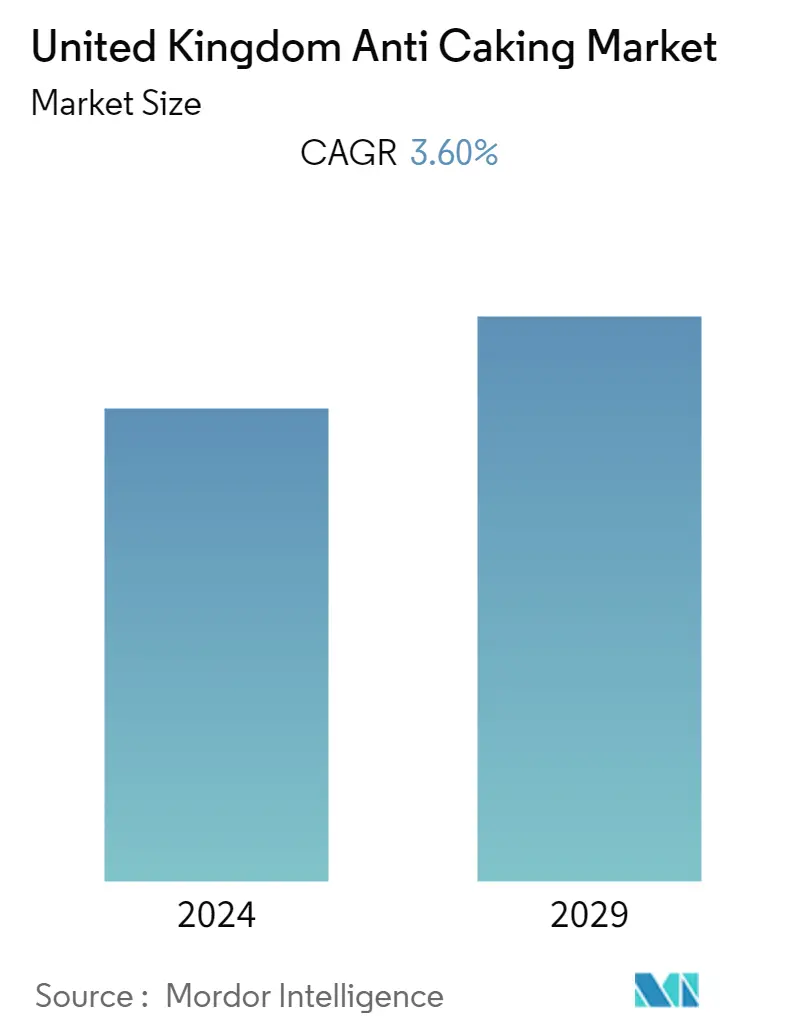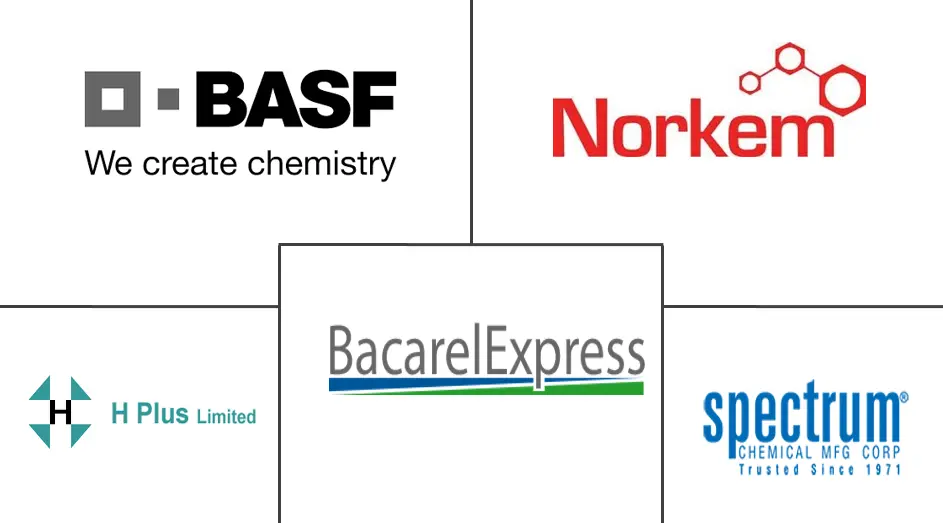Market Size of United Kingdom Anti Caking Industry

| Study Period | 2019 - 2029 |
| Base Year For Estimation | 2023 |
| Forecast Data Period | 2024 - 2029 |
| Historical Data Period | 2019 - 2022 |
| CAGR | 3.60 % |
| Market Concentration | Medium |
Major Players
*Disclaimer: Major Players sorted in no particular order |
UK Anti-Caking Market Analysis
The United Kingdom's anti-caking market is projected to grow at a CAGR of 3.6% during the forecast period 2020 - 2025.
- The market is majorly driven by the rising demand of anti-caking agents in various industries such as food and beverage, cosmetics and personal care industries, pharmaceuticals, and others. This demand in the market is attributed to its property of moisture absorption, which aids food products, feed, and fertilizers in maintaining the fluidity and mixing abilities thereby enhancing the shelf-life of the final product.
- The food and beverage sector dominates the market share among other industries in its application segment. In the food and beverage sector, it is used in bakery, dairy products, soups & sauces, and seasoning & condiments, and beverage industries. It also maintains the free-flow, texture, and organoleptic properties of the product, thus enhancing the shelf-life of the product. Therefore, the high versatility of anti-caking agents is anticipated to further strengthen its demand over the forecast period.
- However, only specific amounts of anti-caking agents, which are classification as 'Generally Recognized as Safe' (GRAS), designated by the US Food and Drug Administration, are permitted in food & beverage applications, therefore limiting its consumption in the aforementioned application. Also, several health hazards and side-effects associated with anti-caking agents are anticipated to negatively impact the growth of the market.
UK Anti-Caking Industry Segmentation
The United Kingdom's anti-caking market is segmented by type into calcium compounds, sodium compounds, magnesium compounds, and others; and by application into food and beverage, cosmetic and personal care, feed, and others. The food & beverages segment is further bifurcated into dairy, bakery, soup & sauces, beverages.
| By Type | |
| Calcium Compounds | |
| Sodium Compounds | |
| Magnesium Compounds | |
| Others |
| By Application | |||||||
| |||||||
| Cosmetics & Personal Care | |||||||
| Feed | |||||||
| Others |
United Kingdom Anti Caking Market Size Summary
The United Kingdom's anti-caking market is experiencing growth driven by increasing demand across various sectors, including food and beverage, cosmetics, personal care, and pharmaceuticals. The primary function of anti-caking agents is to absorb moisture, which helps maintain the fluidity and mixing abilities of products, thereby extending their shelf life. The food and beverage industry holds the largest market share, utilizing these agents in bakery, dairy, soups, sauces, seasonings, and beverages to preserve texture and organoleptic properties. Despite the high versatility and demand for anti-caking agents, their use is regulated due to safety concerns, which may limit consumption in certain applications.
Sodium compounds are particularly prevalent in the food and beverage sector, with regulatory bodies supporting their use in various applications. These compounds, such as sodium bicarbonate and sodium ferrocyanide, are essential in maintaining the free-flowing ability and enhancing the quality of products like beer, soft drinks, and baked goods. The growing consumer preference for convenience and high-quality packaged foods and beverages is further propelling market growth. The UK anti-caking market is competitive and fragmented, with key players like BASF SE, Norkem, and Spectrum Chemical Manufacturing Corporation focusing on strategic mergers, acquisitions, and product development to strengthen their market presence.
United Kingdom Anti Caking Market Size - Table of Contents
-
1. MARKET DYNAMICS
-
1.1 Market Drivers
-
1.2 Market Restraints
-
1.3 Porter's Five Forces Analysis
-
1.3.1 Threat of New Entrants
-
1.3.2 Bargaining Power of Buyers/Consumers
-
1.3.3 Bargaining Power of Suppliers
-
1.3.4 Threat of Substitute Products
-
1.3.5 Intensity of Competitive Rivalry
-
-
-
2. MARKET SEGMENTATION
-
2.1 By Type
-
2.1.1 Calcium Compounds
-
2.1.2 Sodium Compounds
-
2.1.3 Magnesium Compounds
-
2.1.4 Others
-
-
2.2 By Application
-
2.2.1 Food & Beverage
-
2.2.1.1 Bakery Products
-
2.2.1.2 Dairy Products
-
2.2.1.3 Soups & Sauces
-
2.2.1.4 Beverages
-
2.2.1.5 Others
-
-
2.2.2 Cosmetics & Personal Care
-
2.2.3 Feed
-
2.2.4 Others
-
-
United Kingdom Anti Caking Market Size FAQs
What is the current United Kingdom Anti Caking Market size?
The United Kingdom Anti Caking Market is projected to register a CAGR of 3.6% during the forecast period (2025-2030)
Who are the key players in United Kingdom Anti Caking Market?
BASF SE, Norkem, Bacarel and Company Limited, H Plus Limited and Spectrum Chemical Manufacturing Corp. are the major companies operating in the United Kingdom Anti Caking Market.

